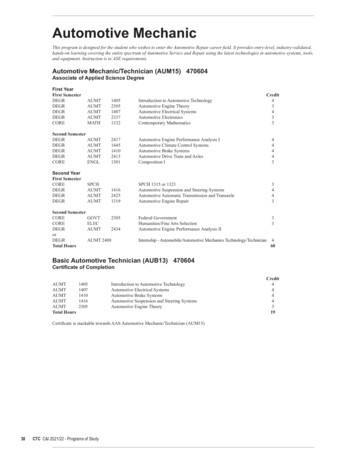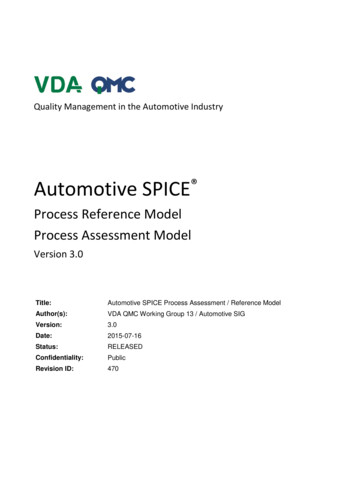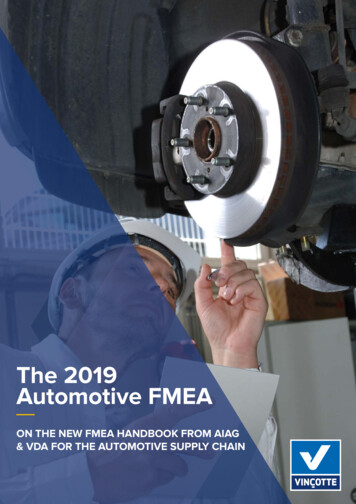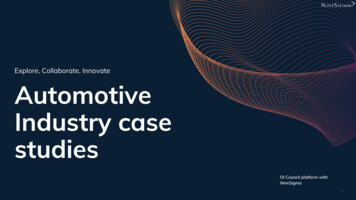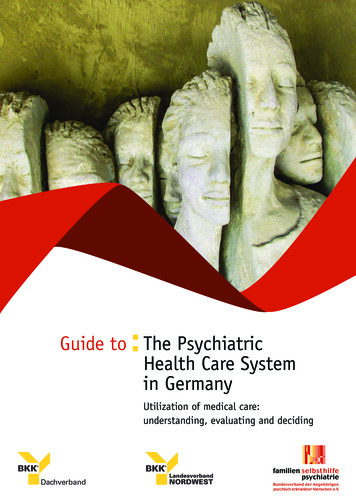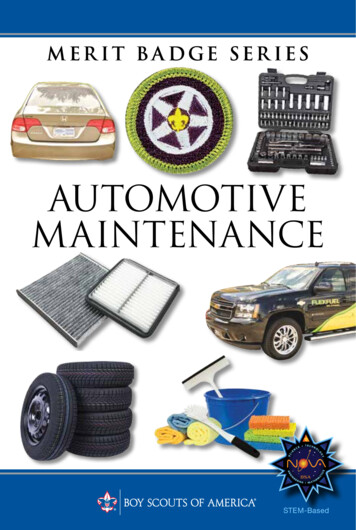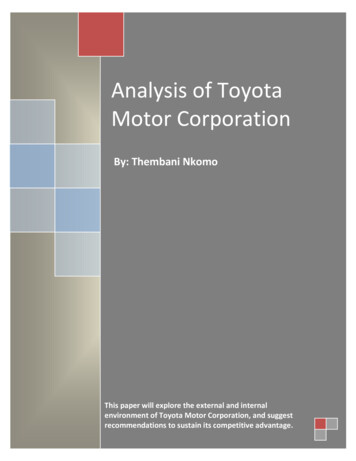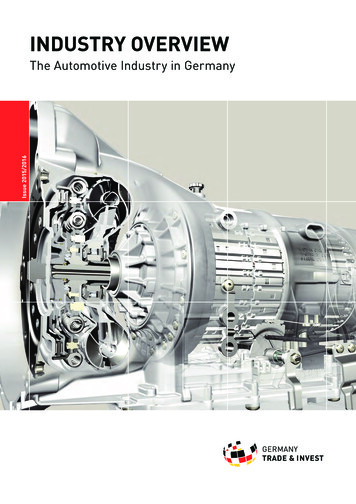
Transcription
INDUSTRY OVERVIEWIssue 2015/2016The Automotive Industry in Germany
THE AUTOMOTIVE INDUSTRY IN GERMANYTHE WORLD’SAUTOMOTIVEINNOVATION HUBTake a look at our impressive numbers and find out why, more than 125years after inventing the automobile,Germany remains the world’s automotive innovation hub.fied workforce create an internationally peerless automotiveenvironment. It enables companiesto develop cutting-edge technologies which perfectly address tomorrow’s mobility needs. In thefuture, Germany will continue tostrive to provide top-class technological performance throughits outstanding infrastructure,prestigious international researchfacilities and dynamic investmentclimate.Germany is recognized the worldover for its outstanding automotiveindustry and excellence in engineering. From Asia to the Americas,German cars embody highly cherished values of innovation, reliability, safety, and design. Germany isby some distance Europe’s leadingproduction and sales market. Thecountry’s world-class R&D infrastructure, complete industry valuechain integration, and highly quali-Finlandlane Sweden3 h by onia1.5 h niusRUBelarusIrelandWarsawBerlinLondon AmsterdamBelgium15 h GERMANYUkraineCzech RepublicParisViennaFranceAustriaBernhPortugal jubljana lovakRepublicHungarySwitzerland 2430 h by train gradeBulgariaSarajevoutrMontenegro MaltaVallettaSource: Germany Trade & Invest 2012Cartography: www.fotolia.de – António DuarteUK
Industry Overview 2015/16 www.gtai.comTHE INDUSTRY INNUMBERSautomotive suppliers are Germancompanies. Germany is the European car production leader: some5.6 million passenger cars - andmore than 303,500 trucks and buses - were manufactured in Germanplants in 2014.EUROPE’S BIGGEST MARKETGermany is Europe’s number oneautomotive market in production andsales terms; accounting for over 30percent of all passenger cars manufactured and almost 20 percentof all new registrations. Germanyalso boasts the largest concentration of OEM plants in Europe. Thereare currently 43 OEM sites locatedin Germany. German OEM marketshare in Western Europe was morethan 51 percent in 2014. Germany isconveniently located next to Poland,the biggest Eastern European market with passenger car unit salesof 325,000 (six percent annual increase) in 2014.GERMANY’S LARGEST INDUSTRYThe automotive industry is the largest industry sector in Germany.In 2014, the auto sector recordedturnover of EUR 384 billion – around20 percent of total German industryrevenue. The automobile industry isone of the largest employers in Germany, with a workforce of around775,000 in 2014; an increase of almost three percent compared to theprevious year.EXPORT SUCCESSGerman passenger car and lightcommercial vehicle manufacturersrecorded foreign market generatedrevenue of more than EUR 251 billion in 2014 - a seven percent plusincrease on 2013 results. The domestic market generated revenueMANUFACTURING LEADERGerman automobile manufacturersproduced almost 15 million vehiclesin 2014 – equivalent to more than 18percent of total global production.Twenty-one of the world’s 100 topof EUR 133 billion – a five percentincrease compared to 2013. Around77 percent of cars produced in Germany in 2014 were ultimately destined for foreign shores – a newrecord. Worldwide, one in five carsthat rolls off the production line ismade by a German OEM.R&D LEADERSHIPGerman OEMs are responsible foraround one third of internationalautomotive R&D expenditure, withR&D investments amounting to EUR17.6 billion in 2014. Germany’s automotive sector is the country’s mostinnovative industry sector, accounting for one third of total Germanindustry R&D expenditure of EUR56 billion in 2014. German automotive companies are responsiblefor more than 60 percent of R&Dgrowth in Europe. R&D personnelwithin the German automobile industry reached a level of 93,000 in2014.European Passenger Car Production and Registration 2014Registration (in million)5.6Production (in 04.0RomaniaSwedenSloveniaSource: ACEA 20153
MARKET OPPORTUNITIESGLOBAL MARKETPERSPECTIVEINCREASING WORLDWIDEDEMANDGlobal demand for vehicles “Madein Germany” remains strong, withexports accounting for three quarters of all domestic vehicle production (equivalent to almost 4.3 million vehicles and an annual increaseof three percent). Germany was themost significant exporter of passenger cars in 2014, ahead of Japanand South Korea.Premium Car Production by Country 201419%6%JapanUKUSAChinaGermanyRest of the World6%13%14%41%Source: GTAI 2015 (analysis based on data derived from MarkLines database)Most German vehicles are exportedto other European countries, withneighbor states accounting for over50 percent of total export levels. Beyond Europe, the USA is the largestimporter of German-made vehiclesfollowed by Asia. German OEMsoccupied almost three quarters ofthe global premium vehicle market, with a similar ratio of premiumsegment vehicles manufacturedfor export purposes. Demand forpremium vehicles is particularlyhigh in China and the USA. Thelargest and most exclusive vehicleshave a major pull in the Chinesemarket, so much so that China is themost important market for a number of German vehicle series.Western European Light Vehicle Production %50%2000*2005MidSegmentEntrySegment*Totals include rounding differencesSource: RolandBerger 2013PREMIUM MARKET HUBGermany is the world’s premiumcar production hub thanks to itsworld-class R&D, labor force, infrastructure, and automotive manufacturing heritage. Of all premiumbranded vehicles produced globally,more than 70 percent are GermanOEM-manufactured. Of all vehiclesproduced globally, almost twothirds of vehicles were produced inEurope (41 percent were made in Germany). Within Europe, more than 80percent are German–OEM badgedvehicles – almost 70 percent of these4PremiumSegmentvehicles are made in Germany. Thewestern European light vehicle production sector is predominantly premium sector focused. As a result,the scale and range of production isexpanding significantly. Productionof premium segment cars reached atotal share of 37 percent of westernEuropean light vehicle productionand will continue to grow.
Industry Overview 2015/16 www.gtai.comPREMIUM MARKET GROWTHA broad consensus exists amongreputable industry analysts that,globally, the premium market segment will grow at a much faster ratethan the total passenger car segment in the next decades. Growthwithin this segment can be mainlyattributed to growing internationaldemand for high-value, premiumsmall and compact-sized cars aswell as premium SUVs. The German automotive industry is theleading producer of premium carsworldwide and continues to set thebenchmark in this segment. TheGerman market is ideally positionedto meet growing international premium demand: Almost all Germanand German-based manufacturershave already launched or intend tolaunch new products meeting premium segment demand. Excellentproduction standards, sustainableinnovation and know-how basedon the country’s automotive manufacturing tradition will furtherstrengthen the leading position ofGermany as a leading internationalautomotive manufacturing location.WORLDWIDE REPUTATIONGerman products and the “Made inGermany“ label are associated withpositive attributes such as quality,reliability, durability, efficiency, andsafety. A GTAI study conducted in 15major world cities finds this to bethe case in all regions of the world;be it Asia, Africa, Australia, Europeor the Americas. The study alsonotes that regional and sectoral differences in terms of importance attached occur in all but one area: theautomotive sector.Assessment of Innovation Power Germany 2013How competitive are the following automotivehubs with respect to innovation power?Very competitiveGermanyJapanSouth KoreaChinaUSABrazilIndiaSwedenFranceRussiaFairly 10%13%6%7%030%28%24%102030405060708090Source: Ernst & Young 2013RISING R&D BUDGETSGerman automotive company investment in research and development remains strong as manufacturers seek to maintain thecompetitiveness of vehicles “Madein Germany.” In 2014, German automotive companies spent aroundEUR 17.6 billion on internal research and development projects;more than any other manufacturingsector in Germany.Almost one third of Germany’s total manufacturing industry R&Dexpenditure is spent by automotivecompanies, with R&D budgets expected to rise. Germany’s automotive companies employ the largestnumber of research personnel in themanufacturing sector. With 93,000researchers (full-time equivalent),automotive companies employ onequarter of the total R&D workforcein Germany’s private economy.MOST INNOVATIVEPRODUCTION LOCATIONGerman cars continue to enjoy aglobally positive image and are inhigh demand across the world. Arecent Ernst & Young study of 300companies active in the Europeanautomotive sector (15 percent OEMsand 85 percent suppliers) findsGermany to be the most innovative automotive hub in internationalcomparison. Eighty-one percent ofthose companies surveyed considerGermany to be the most competitivehub in terms of innovative power(ahead of Japan and South Koreawho polled 65 percent and 61 percent respectively).5
According to McKinsey, the overallmarket value for new vehicles withoptimized combustion engines isset to reach between EUR 280 billion and EUR 330 billion by 2020.Impressive developments have already been made in developingsmaller, highly charged-up “homogeneous combustion” engines anddual clutch transmissions (DCTs).Demand for alternative drive systems is the result of increased environmental awareness, rising gasprices, and more rigorous CO2 regulations for new vehicles. Overallmarket potential for efficient drivesystems is worth between EUR 325billion and EUR 500 billion throughto 2020.E-MOBILITYDomestic and international market potential for energy-efficientpassenger cars is huge. The globalmarket is expected to grow by 29percent annually by 2020. Supported by the country’s ambitious emobility plans, the automotive sector has set itself the goal of becoming a lead provider and market ofelectromobility solutions by 2020.6Battery-electric driveFuel cellsBiomass-to-liquidReplaceGas-to-liquidBiofuels (first generation)GasHybrid driveImprove motor efficienciesFlexible fuel vehiclesComplementReduceDrive train optimizationNEW MOBILITY CONCEPTSHydrogenCAR-2-X COMMUNICATIONLightweight constructionSUSTAINABLE MOBILITYAutomotive engineers in Germanyare hard at work improving internal combustion engine energy efficiency, developing alternative drivetechnologies (including electric, hybrid, and fuel cell cars), and adapting lightweight materials and electronics. Carbon emission reductiontargets, smart traffic management,and the government’s electric mobility initiative are major drivers forfuture mobility growth.German Automotive Industry Diversified Strategy –Technological TrendsRolling resistanceTECHNOLOGICALTRENDSSource: VDA 2013This objective is conceived as thefirst part of a three-stage process:1. Market preparation phase to2014 - R&D and showcase projectfocus; 2. Market ramp-up phase to2017 - Energy-efficient vehicle andinfrastructure market developmentfocus; 3. Mass market phase to2020 - Sustainable business modelfocus.The country also has ambitious emobility plans outside Germany,with German OEMs keen to meetrising export demand for vehicles inthe USA and emerging economies.Economic growth, the changingmobility requirements of a youngand aspirational population, andthe relatively low density of passenger cars are driving demand in theemerging economies. This will allow German-based manufacturersto successfully follow their provenstrategy of increased imports andon-site production.CONNECTIVITYThe demand for connected cars isset to increase significantly, nowhere more so than in the premium segment. Facilitating a raftof innovative safety, comfort andinformation services, smart technologies are revolutionizing thedriving experience. According to atrend study conducted by McKinsey, the number of smart cars willincrease by 30 percent annuallyover the next years.By 2020, one in five cars will be connected to the internet - 50 percentof these vehicles will belong to thepremium segment. Germany’s industry strength in electronic technologies and software solutionsis crucial for technological advancement in this sector.
Industry Overview 2015/16 www.gtai.comSUPPLY CHAINTRANSFORMATIONThe automotive industry is conspicuously changing in terms of its structure, especially in supply chain partnerships. The working relationshipsbetween OEMs and suppliers havebeen transformed by a number of factors including increased model andvariety diversity and shorter productlife cycles; modularization and assembly strategies; high dynamics bythe implementation of new technologies; new e-mobility developmentactivity focus and cost pressures;and high capital intensity levels.NEW OEM BUSINESS MODELSConventional notions of the role ofthe traditional OEM within the automotive industry value chain areslowly but surely being consignedto the past. The classic OEM business model – with its dependenceon turnover generated from newvehicle sales – is undergoing a major paradigm shift as value creationreturns continue to fall. Not only isthe modern driver more discerning in his or her auto-purchasingbehavior, but heightened buyer expectations have created a marketin which there is a car for everyconsumer. As a result, OEMs havefound themselves caught up in a“crowding-out” cycle where evermore and better technological features are required to stay ahead ofa congested international market.Moreover, technological advances,historically the sole preserve of theauto manufacturer, are increasingly taking place on the side of thesupplier. OEMs are accordingly differentiating themselves in terms ofbrand reputation and service.Changing Industry Structures: Development of Share of AddedValue between OEMs and ive TrainInternal CombustionEngine and AggregatesElectric Gearno Source: VDA 2013 (based on Oliver Wyman research)INCREASING THE SUPPLIER’SROLEAccording to the German Associationof the Automotive Industry (VDA),the role of suppliers is noticeably increasing; particularly in the production of drive trains, internal combustion engines (ICEs) and aggregates,bodywork, and exteriors. The VDAalso forecasts that a visible extension of supplier activity areas fordrive trains, ICEs, electric motors,bodywork, and exteriors will takeplace through to 2025. According toMcKinsey, OEMs will also have todeal with rising production volumes.Building a local supplier base, creating an enhanced supply chain, andbolstering capacities are the resultof this development. This is necessary in light of the further development of alternative drives. Supplierswill accordingly become even moreimportant in terms of how much value they add to the product.INCREASING SUPPLIERKNOWLEDGEElectronics and software will play adominant role in vehicle innovation.Approximately 90 percent of automotive innovations in 2014 featuredelectronics and software, more specifically in active safety and infotainment features. This confirms the notion that supply chain partnershipsare becoming increasingly important within the automotive industryvalue chain. Eighty-four percent ofautomotive industry CEOs questioned in the PWC 16th Annual GlobalCEO Survey stress the importanceof strengthening their supply chainpartnerships as a top priority behindmeeting customer and client needs(89 percent of those surveyed).7
Industry Overview 2015/16 www.gtai.comVALUE ADDED INTHE VALUE CHAINAUTOMOTIVE INDUSTRY STRUCTUREThe auto industry in Germany thrives as a result of thediversity of companies active in the sector: large andmedium-sized auto manufacturers alike are to be foundin Germany, as are system and module suppliers - not tomention numerous small and medium-sized tier 2 and3 suppliers. In fact, around 85 percent of auto industry suppliers are medium-sized companies. All of thesesuppliers provide up to 70 percent of value added withinthe domestic auto sector – ensuring that the Germansuppliers by size. Automotive suppliers generatedaround EUR 73 billion of total German automotive industry turnover in 2014 - surpassing the previous 2013record. Exports account for almost 37 percent of 2014revenue generated by German suppliers. The Germanautomotive industry recorded a total revenue volume ofEUR 384 billion in 2014 – equivalent to a six percent increase on 2013 revenue. The domestic market accounted for over EUR 133 billion of this sum, with more thanEUR 251 billion turnover generated in foreign markets(equivalent to a seven percent increase on 2013 revenue). OEM exports account for almost two thirds of totalturnover generated. R&D is a crucial factor in maintaining this leading position, as German-based companiesauto industry remains ahead of the competition. Valueadded is moving to the supplier side, and increasinglyalso to non-auto industry sectors (e.g. the chemical industry in the field of electric mobility). Not unsurprisingly, international suppliers are increasingly attractedto Germany as a business location. To date, the world’sten largest non-German auto industry suppliers havesuccessfully established operations in Germany.GLOBAL SUPPLIERS LEADERGermany boasts 21 of the world’s top 100 automotiveOEM suppliers. Of these 21 companies, 18 belong to thetop 50 automotive suppliers in Europe. Breaking the figures down further still, six belong to the top 25 globalNo other country in Europe can boast a comparable concentration ofauto-related R&D, design, supply, manufacturing, and assembly facilities. Accordingly, no other country in Europe provides the same marketopportunities as those offered by the German auto industry.GERMAN AUTOMOTIVEOEM AND e: Germany Trade & Invest rland109HessenBerlin621 8142035610241261015113 1652227Cartography: roccomontoya – istockphoto.comNo.strive to stay on top of the trends and developments ofa market in transformation. This explains German OEMR&D spending of almost EUR 18 bil lion in 2014 (almostone third of total global automotive R&D expenditure).Central to the successes enjoyed by German OEMs todate are the skilled teams of workers who support ongoing development and production. The German automotive supplying industry employed a workforce of almost 297,600 in 2014. They also serve Europe’s largestautomotive market, where some 5.6 million passengercars and 303,500 light commercial vehicles were produced in 2014.No.Suppliers (only German headquarters)1Bosch2Continental3ZF Friedrichshafen4BASF SE5Schaeffler6Benteler Automobiltechnik7Mahle8Hella KGaA9Brose Fahrzeugteile10Behr11Leoni12Eberspaecher Holding13Webasto SE14Bayer MaterialScience15Draexlmaier16Infineon Technologies17KSPG18Leopold Kostal19TrelleborgVibracoustic20Kautex Textron21HBPO9
R&D INFRASTRUCTUREWORLD’S LEADING AUTOR&D NATIONNo other industry invests as muchin R&D – more than EUR 17.6 billion in 2014 alone. As such, the autoindustry in Germany accounts forone third of the country’s total R&Dexpenditure. Germany has the highest concentration of all Europeanautomotive OEM and tier 0.5 supplier R&D centers. This makes thecountry the most important automotive development activity location in Europe. Suppliers and service providers located in Germanyprofit from close client interactionstarting from the pre-developmentstage. They can take advantage ofjoint research activities with someof the world’s leading automotivetechnology research institutes anduniversities.INCREASING R&D INVESTMENTSAround 93,000 people were engaged in R&D activity in 2014. Aswell as making provision for significant internal R&D expenditure, theGerman automotive sector spends afurther EUR 8.2 billion on externalR&D - this is equivalent to almosthalf of the country’s external R&Dinvestments. Despite record R&Dexpenditure levels, German companies intend to boost their R&Dactivities further still. According tothe Ernst & Young European Automotive Survey, more than 40 percent of German automotive companies want to increase their R&Dinvestments in the future, while 58percent will maintain current R&Dspending levels.10Innovation Intensity – Share of InnovationExpenditures of Turnover10.7%Automotive Industry10%Electronics IndustryInformation & TelecommunicationIndustry7.6%7.2%Chemical Industry5.7%Mechanical Engineeering Industry0%2%4%6%8%10%12%Source: ZEW 2015WORLD INNOVATION LEADERAuto manufacturers and supplierslocated in Germany are among theworld’s leading patent applicants.Nine out of the country’s top tenpatent filing companies are predominately active in the automotive industry – proof positive of thecountry’s importance within theworld’s automotive market and itsenormous innovation power.Germany’s automotive industryremains the country’s leading industry innovator with a significantshare of turnover being generatedfrom new product innovations (56percent in 2014). Almost 70 percentof companies active in the sector introduced new products or processesin 2014. Investment in innovationis constantly increasing, and is expected to reach EUR 47.1 billion bythe end of 2014. Complete industryvalue chain presence ensures thatnew and innovative products aremade to the highest possible technological standards. The biggestGerman automotive supplier alonefiles around 19 patents per workingday on average.R&D INCENTIVES – GERMANY’SHIGH-TECH STRATEGYWith R&D considered to be amongthe most important areas for the development of the German economy,industry and the public sector havemade a commitment to spend aroundthree percent of national GDP peryear on R&D activities. This amountsto approximately EUR 80 billion R&Dspending each year. In addition, anunprecedented campaign to fosterthe advancement of new technologies has been launched by the German government.The High-Tech Strategy representsthe first national concept to bringkey-innovation and technologystakeholders together in a commonpurpose of advancing new technologies. The initiative combinesthe resources of all governmentministries, setting billions of eurosaside annually for the developmentof cutting-edge technologies (R&Dprojects can also count on generous financial support in the form ofR&D grants).
Industry Overview 2015/16 www.gtai.comNew Product Turnover by Industry 201351%Automotive Industry32%Electronics IndustryMechanical & EngineeringIndustry23%18%Textile Industry16%Chemical Industry13%Glass & Ceramics Industry0%20%40%Carbon Composites e. V. (CCeV)Association of companies and researchinstitutions covering the entire valuechain of high-performance, fiber-reinforced composites in Germany (headquarters and four centers), Austriaand Switzerland.24%Information & TelecommunicationIndustryAutomotive Industry R&DCluster Examples: LightweightConstruction60%Source: ZWE 2015Organizes targeted networking andinformation exchange with leadingCFRP experts from R&D and production; provides access to establishedR&D and manufacturing services;offers cooperation possibilities at allstages within the entire value chain.KITe hyLITEAUTOMOTIVE INDUSTRYCLUSTERSThe decentralized nature of the automotive industry has spurred thedevelopment of strong R&D business networks. Non-university research institutes, universities andcompanies work together in numerous federal and regional industryand research clusters to improve orinvent new products, solutions, services, and processes. By connecting individual competencies, major R&D clusters in the automotiveindustry can be identified. Theseclusters have gained internationalrecognition by integrating industry,science and education in automotive-related areas including mechatronics, microelectronics, mechanical engineering, manufacturingprocesses, and material sciences.This has helped the industry to secure an internationally leading position in a number of technology fieldsand secured its status as the international benchmark.INTERNATIONAL RESEARCHCOMPETENCIESIndustrial R&D activities in Germany benefit from a broad innovation landscape which is home to adiverse array of potential researchcooperation partners. Germany alsooffers research cooperation opportunities with the 240 institutes ofthe four large research organizations: Fraunhofer-Gesellschaft, MaxPlanck Society, Helmholtz Association, and Leibniz Association. Their60,000 researchers are globally acknowledged experts in applied andbasic sciences and economicallysuccessful. The Fraunhofer Institutefor Communication Systems ESK inparticular is developing state-ofthe-art vehicle information and communication technologies (ICT). Maincompetencies lie in the fields of automotive networks, infotainment anddriver assistance, and model-drivensoftware.Fraunhofer-Gesellschaft led clusterthat brings together more than 30partners from industry and R&Dfocusing on the development of newtechnologies for hybrid lightweightconstruction.Cluster for Lightweight Design(Leichtbau-Cluster, LC) LandshutNetwork of companies (40 percent),R&D institutes (30 percent) and serviceproviders (30 percent) to assist andpromote cross-industrial cooperationin the field of lightweight design .Key topics within the Cluster for Lightweight Design are materials for lightweight design, design of lightweightstructures, and advanced manufacturing technology for lightweight designapplications.11
EUROPEAN MARKETPERSPECTIVEGROWTH MARKETSThe European automotive industrywill perform best in the developingworld in the years ahead. At home,the sector will consolidate its leading market position, largely as a result of development and growth inthe premium market segment. TheEuropean share of value added inthe premium vehicle segment willbe more pronounced than in otherregions, where the segment is comparatively small or negligible. Chinawill remain a strong performer inthe volume segment, with India alsorecording a significant increase indemand in the small vehicle segment. The US vehicle market is inupturn mode and one of the mostimportant sales markets for GermanOEMs. In global comparison, Europeis the most promising automotiveinvestment location in value-addedterms.COMPETITIVE AND STABLE HUBThe recent PWC 16th Annual GlobalCEO Survey (automotive sector in 32countries) finds that more than 80percent of automotive industry CEOsare most concerned by volatile anduncertain growth, with 70 percent ofCEOs questioned concerned by currency fluctuations. The Eurozone’ssingle, stable currency provides afurther considerable investmentadvantage to prospective investors,thanks to the absence of exchangerate volatility.12European Automotive Hubs Product Quality Assessment 2013How competitive are the following automotivehubs with respect to product quality?Very 34%Italy 6%31%Czech Rep. 4%28%Spain 6%27%Slovak Rep.23%Poland20%Hungary0102030Fairly competitive37%43%405060708090100Source: Ernst & Young 2013A recent Ernst & Young study concludes that German-based automotive hubs record the highest productquality levels – 88 percent of thosesurveyed consider Germany to bethe most competitive hub with thebest quality worldwide. Seventyfour percent of respondents alsoidentified Germany as the world’smost product automotive hub.MANUFACTURING LOCATIONGerman companies represent 10percent of European manufacturingcompanies and generate 27 percentof total EU turnover in this sector.In fact, the manufacturing sectorrepresents more than one fifth ofGermany s “value added” – one of thehighest shares in Europe. Increasingly more international companiesare placing their faith in Germany asa vital production site location, andare benefiting from superior productivity rates and the country’sexcellent business framework ofstable labor costs, excellent production standards, and a highly skilledworkforce.CARS 2020 ACTION PLANIn order to maintain European automotive industry competitivenessand sustainability, the EuropeanCommission set up the CARS 2020Action Plan in 2012. Consisting ofconcrete policy initiative proposals,CARS 2020 directly addresses theopportunities opening up in emerging economies. Central to the initiative’s objectives are four areas ofactivity: 1. The promotion of investment in advanced technologies andinnovation for clean vehicles, 2. Improve market conditions, 3. Supportindustry in accessing the globalmarket, 4. Promote investment inskills and training. Research andinnovation activities will be streamlined under the European GreenVehicle Initiative, with European Investment Bank cooperation providing small and medium-sized enterprises with access to credit.
INVESTMENT CLIMATEEUROPE’S MOSTATTRACTIVE AUTOMOTIVE LOCATIONAUTOMOTIVE FDI MAGNETAccording to Ernst & Young’s European Attractiveness Survey 2014,Germany continues to be seen asthe most attractive FDI destinationin Europe. Ernst & Young’s StandortDeutschland (“Location Germany”)report sees Germany placed asthe world’s fourth most attractiveinvestment location behind China,USA and Russia. Germany has beenable to further expl
German products and the “Made in . Germany“ label are associated with positive attributes such as quality, reliability, durabil

